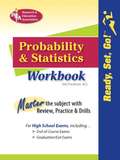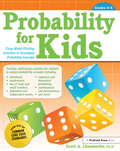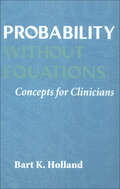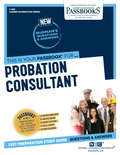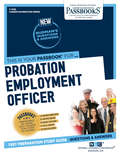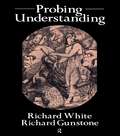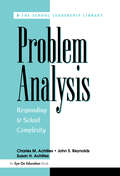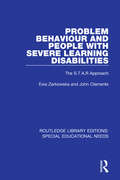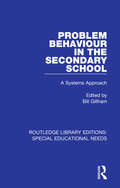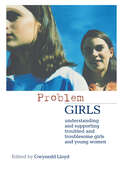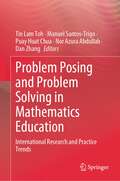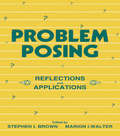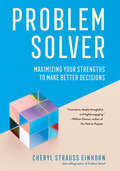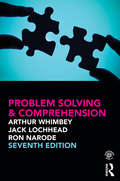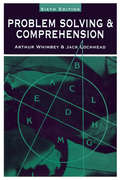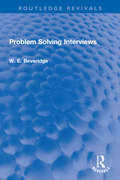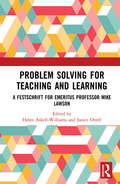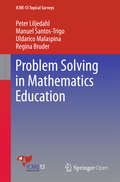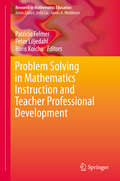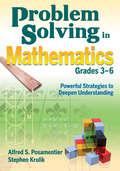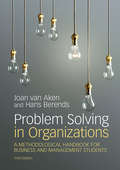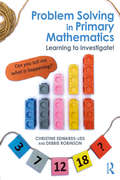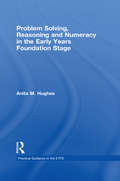- Table View
- List View
Probability and Statistics Workbook (Mathematics Learning And Practice Ser.)
by Mel FriedmanProbability and Statistics Workbook an Easy-to-Use Workbook Series for Students Struggling with Math A Perfect Study Tool for Exit Exams, End-of-Course Exams, or Graduation Exams. Many students continue to struggle in high school math courses because they failed to master the basic mathematical skills. REA's Ready, Set, Go! Workbook series takes the confusion out of math, helping students raise their grades and score higher on important exams. What makes REA's workbooks different? Students will actually like using them. Here's why: * Math is explained in simple language, in an easy-to-follow style * The workbooks allow students to learn at their own pace and master the subject * Each lesson is devoted to a key math concept and includes step-by-step examples * Paced instruction with drills and quizzes reinforce learning * Every answer to every question, in every test, is explained in full detail * A final exam lets students test what they've learned. When students apply the skills they've mastered in our workbooks, they can do better in class, raise their grades, and score higher on the all-important end-of-course, graduation, and exit exams Whether used in a classroom, for home or self-study, or with a tutor, this workbook gets students ready for important math tests and exams, set to take on new challenges, and helps them go forward in their studies!
Probability for Kids: Using Model-Eliciting Activities to Investigate Probability Concepts (Grades 4-6)
by Scott ChamberlinProbability for Kids features real-world probability scenarios for students in grades 4-6. Students will encounter problems in which they read about students their age selling magazines for a school fund raiser, concerned about their homeroom assignments, and trying to decode the combination to a safe that their grandfather abandoned, among others, all of which maximizes learning so students gain a deep understanding of concepts in probability. This book will help teachers, parents, and other educators to employ best practices in implementing challenging math activities based on standards. Problem solvers who complete all six activities in the book will understand the six basic principles of probability and be high school ready for discussions in probability. Grades 4-6
Probability without Equations: Concepts for Clinicians
by Bart K. HollandAn award-winning teacher gives a non-technical explanation of the probability and statistics needed by physicians to interpret laboratory results.Although few physicians, nurses, dentists, and other health professionals perform laboratory tests themselves, they all need to be able to interpret the results as well as understand findings reported in the medical literature. A general understanding of probability and statistics is essential for those needing to make daily decisions about the significance of research data, drug interaction precautions, or a patient's positive laboratory test for a rare disease.Written with these needs in mind, Probability without Equations offers a thorough explanation of the subject without overwhelming the reader with equations and footnotes. Award-winning teacher Bart Holland presents a nontechnical treatment of intuitive concepts and presents numerous examples from medical research and practice. In plain language, this book explains the topics that clinicians need to understand:• Analysis of variance• "P-values" and the "t-test"• Hazard models• Regression and correlations• Alpha and beta errors"The Nobel prize-winning physicist Ernest Rutherford was fond of saying that if you need statistics to analyze the results of an experiment, you don't have a very good experiment. In a way he was right. However, a recurrent problem in medicine is that in a certain sense you commonly don't have a good experiment—but not because medical research scientists are generally incompetent! The nature of the data they work with is simply not as predictable as the data in some other fields, so the predictive nature of findings in medical science is generally rather imperfect."—from the introduction
Probation Consultant: Passbooks Study Guide (Career Examination Series)
by National Learning CorporationThe Probation Consultant Passbook® prepares you for your test by allowing you to take practice exams in the subjects you need to study. It provides hundreds of questions and answers in the areas that will likely be covered on your upcoming exam.
Probation Employment Officer: Passbooks Study Guide (Career Examination Series)
by National Learning CorporationThe Probation Employment Officer Passbook® prepares you for your test by allowing you to take practice exams in the subjects you need to study. It provides hundreds of questions and answers in the areas that will likely be covered on your upcoming exam.
Probing Understanding
by Richard White Richard GunstoneThis work aims to provide teachers at all levels and in all subjects with a greater range of practical methods for probing their students' understanding. These probes are presented in the manner of a starting set, to act as a stimulus to invention, rather than as a comprehensive list.
Problem Analysis
by John Reynolds Susan Achilles Charles AchillesThis book explores the relationship between problem analysis, leadership, decision making, and change. It contains many problem scenarios, case studies, and vignettes.
Problem Based Learning in Dermatology
by Steven R. Feldman William W. Huang Rithi John Chandy Rima I. Ghamrawi Veronica Emmerich Courtney E. HeronThis book presents 15 cases as studies in how to reach a diagnosis from a presenting patient. It covers 15 major topics in clinical dermatology as a succinct reference for dermatology clinicians in practice, also offering a concise revision guide for those in training, from medical students and resident physicians preparing for higher examinations to established physicians in their continuing professional development. Covers essential points in clinical dermatology for practice and training or revision and review for boards or certification. Presents a succinct resource for dermatologists, family physicians, and other professionals with an interest in problems of the skin, nails, and hair. Offers a one-stop guide to 15 core topics.
Problem Behaviour and People with Severe Learning Disabilities: The S.T.A.R Approach (Routledge Library Editions: Special Educational Needs #62)
by John Clements Ewa ZarkowskaFirst published in 1994. This book is a practical guide for those involved in the daily care, education and development of people with learning disabilities and additional behavioural and emotional disturbances. It will assist professional helpers in understanding the nature of an individual’s difficulties and in developing interventions aimed at alleviating them.
Problem Behaviour in the Secondary School: A Systems Approach (Routledge Library Editions: Special Educational Needs #27)
by Bill GillhamFirst published in 1981. The inadequacy of traditional ‘solutions’ is nowhere more apparent than in the area of problem behaviour in secondary schools. Neither tough-minded punishment nor tender-minded treatment seems to be the answer. But the practical failure is also a theoretical one, since it misconstrues the determinants of behaviour. Taking a system perspective, Bill Gillham argues in his introductory chapter that ‘our conception of the individual has been too narrow’, so that both treatment and punishment approaches have missed out important elements in an adequate psychology of individuals: the roles they fill, the tasks they perform, the people they encounter – and the institutional settings where all these are experienced. Drawing together a wide range of theory, evidence and practice, the present book makes out a case for a school-centred, interactionist, approach to dealing with problem behaviour.
Problem Girls: Understanding and Supporting Troubled and Troublesome Girls and Young Women
by Gwynedd LloydThis book explores the issues surrounding girls and young women who are seen as troubled or troublesome. It sets out to further our understanding of young women who face or cause difficulties, offering a diverse and complex view. Recognising the increasing importance of schools as the primary source of support for girls and young women, the chapters discuss the implications for practice of teachers and other professionals, covering important issues like: girls' classroom behaviour mental health problems violence and sexuality exclusion and community offences. By presenting a range of theoretical perspectives, readers of this book will be encouraged to reflect on what underpins the actions of girls and young women and take their voices seriously. It will be essential reading for practitioners and professionals in Education, as well as students and academics in the field.
Problem Posing and Problem Solving in Mathematics Education: International Research and Practice Trends
by Dan Zhang Manuel Santos-Trigo Tin Lam Toh Puay Huat Chua Nor Azura AbdullahThis book presents both theoretical and empirical contributions from a global perspective on problem solving and posing (PS/PP) and their application, in relation to the teaching and learning of mathematics in schools. The chapters are derived from selected presentations in the PS/PP Topical Study Group in ICME14. Although mathematical problem posing is a much younger field of inquiry in mathematics education, this topic has grown rapidly. The mathematics curriculum frameworks in many parts of the world have incorporated problem posing as an instructional focus, building on problem solving as its foundation. The juxtaposition of problem solving and problem posing in mathematics presented in this book addresses the needs of the mathematics education research and practice communities at the present day. In particular, this book aims to address the three key points: to present an overview of research and development regarding students’ mathematical problem solving and posing; to discuss new trends and developments in research and practice on these topics; and to provide insight into the future trends of mathematical problem solving and posing.
Problem Posing: Reflections and Applications
by Stephen I. Brown Marion I. WalterAs a result of the editors' collaborative teaching at Harvard in the late 1960s, they produced a ground-breaking work -- The Art Of Problem Posing -- which related problem posing strategies to the already popular activity of problem solving. It took the concept of problem posing and created strategies for engaging in that activity as a central theme in mathematics education. Based in part upon that work and also upon a number of articles by its authors, other members of the mathematics education community began to apply and expand upon their ideas. This collection of thirty readings is a testimony to the power of the ideas that originally appeared. In addition to reproducing relevant materials, the editors of this book of readings have included a considerable amount of interpretive text which places the articles in the context of problem solving. While the preponderance of essays focus upon mathematics and mathematics education, some of them point to the relevance of problem posing to other fields such as biology or psychology. In the interpretive text that accompanies each chapter, they indicate how ideas expressed for one audience may be revisited or transformed in order to ready them for a variety of audiences.
Problem Solver: Maximizing Your Strengths to Make Better Decisions (AREA Method Publications)
by Cheryl Strauss EinhornOur decisions are expressions of who we are and how we move through the world. Rarely, though, do we examine our decisions or even look inward to consider the psychology of our decision-making. Instead, we often make decisions based on what we call instinct (which relies on cognitive bias), false assumptions, mis-remembering, and mental mistakes. Truthfully, we don't see the world as it is; we see it as we are. We can develop self-knowledge about our decision-making styles. We can wake ourselves up to how biases cloud our judgment and impede good decision-making—and we can counter bias. From there, we can transform our decision-making habits to make better big decisions alone and together. Problem Solver provides you with tools to identify:• The five basic decision-making approaches, or "Problem Solver Profiles" (PSPs): Adventurer, Detective, Listener, Thinker, and Visionary • Your dominant—and secondary—PSPs• Tools to assess other peoples' PSPs• Each PSP's decision-making strengths, blind spots, and biases• How your PSP impacts your outlook on life and your risk appetite• How to use your PSP to maximize your decision strengths Replete with real-life examples and replicable strategies to apply new decision-making skills for your immediate benefit, Problem Solver will do more than help you look out into a future; it will equip you to move forward, with confidence, into your future.
Problem Solving & Comprehension
by Arthur Whimbey Jack Lochhead Ronald NarodeThis popular book shows students how to increase their power to analyze problems and comprehend what they read using the Think Aloud Pair Problem Solving [TAPPS] method. First it outlines and illustrates the method that good problem solvers use in attacking complex ideas. Then it provides practice in applying this method to a variety of comprehension and reasoning questions, presented in easy-to-follow steps. As students work through the book they will see a steady improvement in their analytical thinking skills and become smarter, more effective, and more confident problem solvers. Not only can using the TAPPS method assist students in achieving higher scores on tests commonly used for college and job selection, it teaches that problem solving can be fun and social, and that intelligence can be taught. Changes in the Seventh Edition: New chapter on "open-ended" problem solving that includes inductive and deductive reasoning; extended recommendations to teachers, parents, and tutors about how to use TAPPS instructionally; Companion Website with PowerPoint slides, reading lists with links, and additional problems.
Problem Solving & Comprehension: A Short Course in Analytical Reasoning
by Arthur Whimbey Jack Lochhead Ronald NarodeThis popular book shows students how to increase their power to analyze problems and to comprehend what they read. First, it outlines and illustrates the method that good problem solvers use in attacking complex ideas. Then, it provides practice in applying these methods to a variety of comprehension and reasoning questions. Books on the improvement of thinking processes have tended to be complicated and less than useful, but the authors of this renowned text emphasize a simple but effective approach. The "Whimbey Method" of teaching problem solving is now recognized as an invaluable means of teaching people to think. Problems are followed by their solutions, presented in easy-to-follow steps. This feature permits students to work without supervision, outside the classroom. As students work through the book they will see a steady improvement in their analytical thinking skills, and will develop confidence in their ability to solve problems--on tests; in academic courses; and in any occupations that involve analyzing, untangling, or comprehending knotty ideas. By helping students to become better problem solvers, this book can assist students in achieving higher scores on tests commonly used for college and job selection, such as: * Scholastic Aptitude Test (SAT) * Graduate Record Examination (GRE) * ACT Work Keys * Terra Nova * Law School Admission Test (LSAT) * Wonderlic Personnel Test * United States Employment Service General Aptitude Test Battery * Civil Service Examination New in the 6th edition: A totally new chapter--"Meeting Academic and Workplace Standards: How This Book Can Help"--describes changes in the educational system in the past 20 years and shows how the techniques taught in this book relate to the new educational standards and tests. Changes throughout the book reflect current educational and social realities: the names of some characters have been changed to represent more accurately the cross-section of students attending today's schools; dates in some problems have been changed; in other problems the technology referred to has been updated.
Problem Solving Interviews (Routledge Revivals)
by W. E. BeveridgeFirst published in 1968, Problem Solving Interviews explores different elements relating to conversations concerned with finding a solution to a particular problem. The book begins first by examining the role of the problem-solving interviewer, before exploring in detail what an interview is. It looks at the significance of different attitudes in shaping behaviour and highlights the importance of considering the attitudes of both the interviewer and the respondent. This leads on to a consideration of bias, including where it comes from, how it can affect the interview, and whether its impact can be eliminated or reduced. The book also covers carrying out and learning how to interview, and includes close analysis of three example interviews.
Problem Solving for Teaching and Learning: A Festschrift for Emeritus Professor Mike Lawson
by Helen Askell-Williams Janice OrrellProblem Solving for Teaching and Learning explores the importance of problem solving to learning in everyday personal and social contexts. This book is divided into four sections: Setting the scene; Conceptualising problem solving; Teachers’ knowledge and beliefs about problem solving; and Fostering students’ problem-solving capabilities, allowing readers to gain an insight into the various sub-topics that problem solving in learning and teaching introduce. Drawing together diverse perspectives on problem solving located in a variety of educational settings, this book explores problem solving theory, including its cognitive architecture, as well as attending to its translation into teaching and learning in a range of settings, such as education and social environments. This book also suggests how effective problem-solving activities can be incorporated more explicitly in learning and teaching and examines the benefits of this approach. The ideas developed in Problem Solving for Teaching and Learning will act as a catalyst for transforming practices in teaching, learning, and social engagement in formal and informal educational settings, making this book an essential read for education academics and students specialising in cognitive psychology, educational psychology, and problem solving.
Problem Solving in Mathematics Education
by Peter Liljedahl Regina Bruder Manuel Santos-Trigo Uldarico MalaspinaThis survey book reviews four interrelated areas: (i) the relevance of heuristics in problem-solving approaches why they are important and what research tells us about their use; (ii) the need to characterize and foster creative problem-solving approaches what type of heuristics helps learners devise and practice creative solutions; (iii) the importance that learners formulate and pursue their own problems; and iv) the role played by the use of both multiple-purpose and ad hoc mathematical action types of technologies in problem-solving contexts what ways of reasoning learners construct when they rely on the use of digital technologies, and how technology and technology approaches can be reconciled. "
Problem Solving in Mathematics Instruction and Teacher Professional Development (Research in Mathematics Education)
by Peter Liljedahl Patricio Felmer Boris KoichuRecent research in problem solving has shifted its focus to actual classroom implementation and what is really going on during problem solving when it is used regularly in classroom. This book seeks to stay on top of that trend by approaching diverse aspects of current problem solving research, covering three broad themes. Firstly, it explores the role of teachers in problem-solving classrooms and their professional development, moving onto—secondly—the role of students when solving problems, with particular consideration of factors like group work, discussion, role of students in discussions and the effect of students’ engagement on their self-perception and their view of mathematics. Finally, the book considers the question of problem solving in mathematics instruction as it overlaps with problem design, problem-solving situations, and actual classroom implementation. The volume brings together diverse contributors from a variety of countries and with wide and varied experiences, combining the voices of leading and developing researchers. The book will be of interest to any reader keeping on the frontiers of research in problem solving, more specifically researchers and graduate students in mathematics education, researchers in problem solving, as well as teachers and practitioners.
Problem Solving in Mathematics, Grades 3-6: Powerful Strategies to Deepen Understanding
by Alfred S. Posamentier Stephen KrulikWith sample problems and solutions, this book demonstrates how teachers can incorporate nine problem solving strategies into any mathematics curriculum to help students succeed.
Problem Solving in Organizations
by Hans van der Bij Hans Berends Joan Ernst van AkenThis concise introduction to the methodology of Business Problem Solving (BPS) is an indispensable guide to the design and execution of practical projects in real organizational settings. The methodology is both result-oriented and theory-based, encouraging students to use the knowledge gained on their disciplinary courses, and showing them how to do so in a fuzzy, ambiguous and politically charged real life business context. The book provides in-depth discussion of the various steps in the process of business problem solving. Rather than presenting the methodology as a recipe to be followed, the authors demonstrate how to adapt the approach to specific situations and to be flexible in scheduling the work at various steps in the process. It will be indispensable to MBA students who are undertaking their own field work.
Problem Solving in Organizations (3rd Edition): A Methodological Handbook for Business and Management Students
by Hans Berends Joan Van AkenAn indispensable guide enabling business and management students to develop their professional competences in real organizational settings, this new and fully updated edition of Problem Solving in Organizations equips the reader with the necessary toolkit to apply the theory to practical business problems.<P> By encouraging the reader to use the theory and showing them how to do so in a fuzzy, ambiguous and politically charged, real-life organizational context, this book offers a concise introduction to design-oriented and theory-informed problem solving in organizations. In addition, it gives support for designing the overall approach to a problem-solving project as well as support for each of the steps of the problem-solving cycle: problem definition, problem analysis, solution design, interventions, and evaluation. <P>Problem Solving in Organizations is suitable for readers with a wide range of learning objectives, including undergraduates and graduates studying business and management, M.B.A students and professionals working in organizations.<P> Encourages readers to use the theory gained in their disciplinary courses by showing them how to problem solve in fuzzy, ambiguous and politically charged, real-life organizational contexts.<P>Provides an in-depth explanation of the various aspects of organizational problem-solving, showing how to adapt the approach to specific situations and how to be flexible in scheduling the work.<P>Theories are illustrated throughout with examples from real-life problem-solving projects, helping readers to understand the complexities that they will encounter in the field.
Problem Solving in Primary Mathematics: Learning to Investigate!
by Debbie Robinson Christine Edwards-LeisProblem Solving in Primary Mathematics is an essential text designed to support new and experienced teachers in guiding pupils through mathematical investigations and problem solving, offering a framework that children themselves can begin to adopt as they progress to greater metacognitive awareness. Underpinned by the latest international research and theory, it examines how individual pupils think and act differently and offers guidance on how to promote independence and autonomy in the classroom. It examines key topics such as: Preparing for mathematical learning Designing learning material Assessing and evaluating learning Identifying key points for intervention What to do when learning is stalled Critical numeracy for real-world problem solving Mental Model Theory and the Mental Model Mode Different approaches to problem solving and investigating Aimed at new and experienced educators, particularly those with a maths specialism, and illustrated with investigations and activities, Problem Solving in Primary Mathematics demonstrates how frameworks can be used in key mathematical areas and assists students in progressing towards more meaningful problem solving.
Problem Solving, Reasoning and Numeracy in the Early Years Foundation Stage (Practical Guidance in the EYFS)
by Anita M HughesThe Practical Guidance in the Early Years Foundation Stage series will assist practitioners in the smooth and successful implementation of the Early Years Foundation Stage. Each book gives clear and detailed explanations of each aspect of Learning and Development and encourages readers to consider each area within its broadest context to expand and develop their own knowledge and good practice. Practical ideas and activities for all age groups are offered along with a wealth of expertise of how elements from the practice guidance can be implemented within all early years settings. The books include suggestions for the innovative use of everyday ressources, popular books and stories. This book offers an in-depth understanding of children's thinking skills from a psychological perspective. The book introduces the Learning Tools model, a vital cognitive tool used by children to learn and solve problems, and gives practical ideas on how practitioners can use everyday materials to promote problem solving and early numeracy skills through play. Readers are encouraged to reflect on their own practice and understanding to help them provide learning opportunities to meet the unique needs of all children in their setting.
